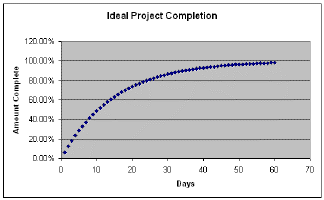Successful Project Management
by Tyrone "let's just polish that 17th decimal place" White
The basic tenets of the theory are (as adapted by Tyrone):
- Never complete a project
until either the money has run out or it's no longer cool to be working on
it.
- Always have a very complex diagram you can put in front of someone so that they think that you must be doing a really good job.
- Always have at least
fifteen extra things you need to do before the project will be completed.
- If things are getting too
intense, cruise the office and talk to the guys and gals.
- Never put 'Final' on anything.
![]()

Though this basic theory provides a good approximation for most of the duration of a project, the really difficult bit comes in the tricky 'near-end' phase. Here we have to define the 'Limits' where project termination becomes unavoidable. Again these are dependent on the type of project (reimbursable, fixed price etc), but require a mathematical definition of events such as:
- When the customer says 'You've spent how much!' (this is specific to reimbursable contracts)
- When the accuracy of the answer has reached the number of decimal places on your calculator
- When the cost per unit value for the customer exceeds the GNP of a small country (reimbursable contracts again)
This last point is illustrated in the graph below, where, as the progress asymptotes to 100% and the expenditure remains constant, the cost per unit value increases exponentially

By combining the 'Tee' factor with 'Disaster Theory' and 'Chaos Theory' the underlying mathematical support for ETERNAL has been developed. Now known as the 'Bugger, is That the Time? Conjecture', it gives us the ultimate project delivery mechanism